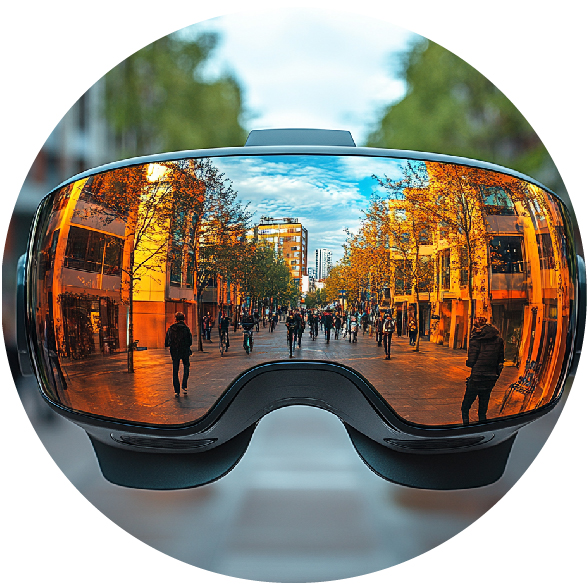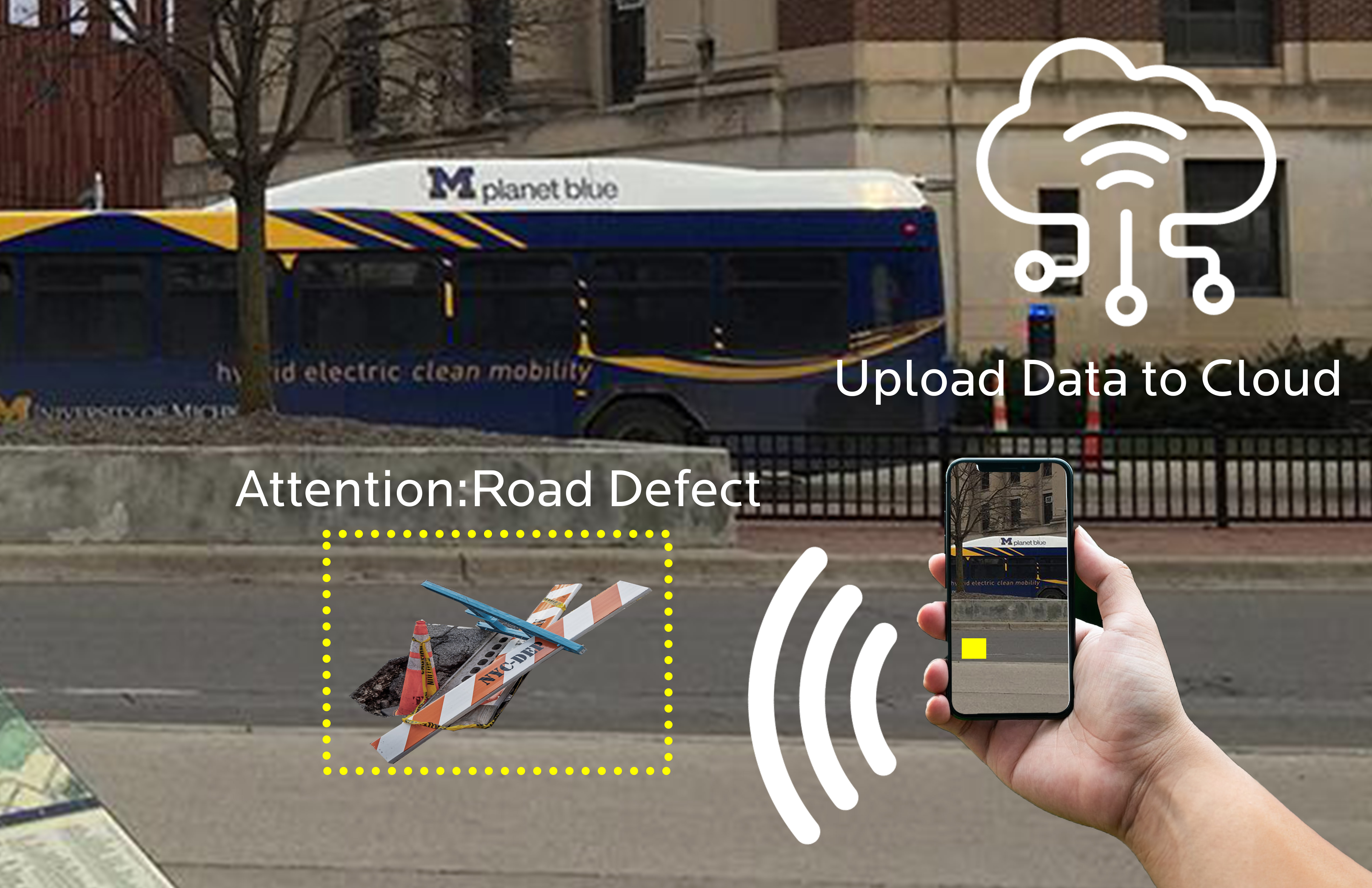
︎ Campus Compass: MR Solutions for Accessibility
Imagine a campus where everyone navigates safely and independently. Using MR(Mixed Reality) glasses, MR technology, and ultra-wideband positioning, our solution offers real-time path analysis, obstacle detection, auditory cues, and responsive signals. We’re augmenting the existing barriers and redefning accessibility for a safer, more inclusive environment.By Siddhi Gosalia ︎ , Chun Wang ︎, Po-Chun,Chou ︎

Who
Students with disabilities make up a signifificant part of the campus population but face unique challenges moving around. Barriers like construction, crowded walkways, uneven paths, and poor lighting make it hard for them to travel safely, even on ADA-compliant campuses. These diffificulties affect their confifidence, independence, and ability to connect socially, often leading to stress and isolation. This project focuses on solving these issues to create a more welcoming campus for all.
Why
Since students with impairments make up a sizable fraction of the university population, the research tackles the pressing need to improve campus mobility for them. Temporary construction, congested walkways, uneven flfloors, and inadequate lighting make it diffificult to navigate safely and independently even when ADA rules are followed. These obstacles affect students' self-esteem and independence in addition to restricting access. Through the use of MR technology, and sophisticated positioning technologies, the research aims to provide different approaches that ensure safer, easier-to-access routes. In the end, it seeks to promote inclusion by enabling people with disabilities to move freely and confifidently around campus environments.
How
To further understand the difficulties of mobility for people with disabilities, a site analysis needs to be conducted to find the road condition problems and potential barriers on campus (Slopes, intersection without lights, one-side pedestrian, construction). The expected site Analysis method is that the City of Ann Arbor can collect the walking paths of users and develop a real-time algorithm to find out which paths most users will avoid.
In response to these findings, we will research precedents through literature study and analyze how scholars have applied different techniques to help solve mobility challenges for disabled groups. Then, based on the study results we will come up with a comprehensive solution that can be implemented to the University of Michigan Ann Arbor campus to help people with disabilities navigate and move on campus.
- Field Analysis: Conduct an in-depth study of the University of Michigan campus to identify specific barriers, such as: Steep slopes, unlit intersections, narrow pathways, and construction zones.
- Data Collection and Algorithms: Use UWB-enabled devices to gather real-time walking path data. Algorithms will analyze this data to highlight paths that are frequently avoided, revealing potential problem areas.
- Literature Review: Examine existing research and successful case studies to explore how similar issues have been addressed with technology.
- Solution Development: Design a comprehensive system that integrates MR glasses, UWB positioning, and accessible feedback mechanisms.

Potential Road Barriers for People with disabilities (Map of University of Michigan Ann Arbor North Campus)
What
We expect to use MR glasses combined with sound assistance in combination with an app on your phone to allow people with disabilities to walk safely on campus. Since the current wireless transmission technology and the most accurate positioning system for mobile phones is the Ultra-wideband system, we expect to use this technology to perform major auxiliary functions. we will develop and apply MR technology to assist individuals with disabilities to safely move around campus:
-
Obstacle Detection: Use an MR glass camera and its mobile laser scanning data to identify potential barriers and generate enhanced analysis figures on a mobile screen or MR glass. Use a mobile device microphone to collect alert sounds, for example car horn.
- Potential Threats Prevention: Provide auditory cues for the visually impaired group describing the current environment the user is located. Threat alerts can be sent through haptic wearables.
- Discharge Responsive Signal: When people use this application to cross intersections or move within a large crowd, responsive lighting and sound will be sent to let the surrounding people and cars identify them.




Road Barrier Alert System Combining Mobile Application Interface, Mobile Vibration, Audio Guide, and MR Glass Interface
So What
This research has significance because it could enhance campus inclusiveness without altering the physical environment. Leveraging advanced technologies like mobile navigation apps and MR glasses, it enables individuals with impairments to navigate around campus buildings functioning with health and well-being safely and independently. This strategy maximises accessibility while lowering infrastructure expenditures. As a result, students with disabilities can participate more actively in academic and social activities, in an egalitarian and socially healthy campus environment. The research demonstrates how technology can bridge the gap between preservation & accessibility, opening new avenues for community involvement and inclusion.
Design To Outcomes
- Improved Navigation: Individuals with disabilities can move independently and safely through real-time obstacle detection, mobile vibration feedback, and sound alerts.
-
Enhanced Campus Inclusivity:
The system fosters an accessible and inclusive environment without requiring
significant infrastructure changes.
- Increased Social and Academic Engagement: Students with disabilities can participate more actively in campus activities, promoting equality and community integration.
Links to Follow:
︎︎︎Two Page Report
︎︎︎Final Video
︎
Works Cited
-
U.S. Department of Justice. Americans with Disabilities Act (ADA) Standards for
Accessible Design. https://www.ada.gov. Accessed 28 Nov. 2024.
- Keating, Daniel, and Chris Lim. "Applications of AR and VR for People with
Disabilities." Journal of Accessible Technology, vol. 15, no. 3, 2021, pp. 210–25.
- Zafari, Faheem, Andreas Gkelias, and Kin K. Leung. "A Survey of Indoor
Localization Systems and Technologies." IEEE Communications Surveys &
Tutorials, vol. 21, no. 3, 2019, pp. 2568–599.
- Kochtitzky, Christine S., and Alex Freeland. "Inclusive Campus Infrastructure for
Individuals with Disabilities." Journal of Campus Planning and Design, vol. 42,
no. 2, 2020, pp. 45–60.
- Guerreiro, Tiago, Dragan Ahmetovic, and Kishore Palani. "Haptic and Auditory
Feedback for Navigating Complex Environments." Proceedings of the ACM on
Human-Computer Interaction, vol. 4, 2020, pp. 1–20.
- Kaplan, Benjamin, and Rachel Bogard. "Emerging Mobility Technologies for
University Campuses." Smart Cities and Urban Innovation, vol. 6, no. 1, 2022, pp.
85–100.